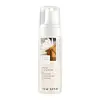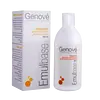What's inside
What's inside
 Key Ingredients
Key Ingredients

 Benefits
Benefits

 Concerns
Concerns

 Ingredients Side-by-side
Ingredients Side-by-side

Water
Skin ConditioningSodium Laureth Sulfate
CleansingPropylene Glycol
HumectantTea-Lauryl Sulfate
CleansingLaureth-2
CleansingCocamidopropyl Betaine
CleansingHydrolyzed Corn Protein
Skin ConditioningParfum
MaskingPEG-12 Dimethicone
Skin ConditioningPhenoxyethanol
PreservativeMethylparaben
PreservativeLimonene
PerfumingLinalool
PerfumingPolyquaternium-10
Citric Acid
BufferingDisodium EDTA
Camellia Sinensis Leaf Extract
AntimicrobialSodium Acetate
BufferingSodium Chloride
MaskingIsopropyl Alcohol
SolventMethylchloroisothiazolinone
PreservativeMethylisothiazolinone
PreservativeWater, Sodium Laureth Sulfate, Propylene Glycol, Tea-Lauryl Sulfate, Laureth-2, Cocamidopropyl Betaine, Hydrolyzed Corn Protein, Parfum, PEG-12 Dimethicone, Phenoxyethanol, Methylparaben, Limonene, Linalool, Polyquaternium-10, Citric Acid, Disodium EDTA, Camellia Sinensis Leaf Extract, Sodium Acetate, Sodium Chloride, Isopropyl Alcohol, Methylchloroisothiazolinone, Methylisothiazolinone
Water
Skin ConditioningLaureth-2
CleansingPotassium Cocoyl Hydrolyzed Collagen
Skin ConditioningDecyl Glucoside
CleansingSodium Lauroyl Sarcosinate
CleansingPolysorbate 80
EmulsifyingSodium Chloride
MaskingSulfur
AntiseborrhoeicTrideceth-9
EmulsifyingPEG-5 Ethylhexanoate
EmulsifyingCitric Acid
BufferingPhenoxyethanol
PreservativeMethylparaben
PreservativeEthylparaben
PreservativeButylparaben
MaskingPropylparaben
PreservativeMethylchloroisothiazolinone
PreservativeMethylisothiazolinone
PreservativeMagnesium Nitrate
Parfum
MaskingLinalool
PerfumingGeraniol
PerfumingLimonene
PerfumingWater, Laureth-2, Potassium Cocoyl Hydrolyzed Collagen, Decyl Glucoside, Sodium Lauroyl Sarcosinate, Polysorbate 80, Sodium Chloride, Sulfur, Trideceth-9, PEG-5 Ethylhexanoate, Citric Acid, Phenoxyethanol, Methylparaben, Ethylparaben, Butylparaben, Propylparaben, Methylchloroisothiazolinone, Methylisothiazolinone, Magnesium Nitrate, Parfum, Linalool, Geraniol, Limonene
Ingredients Explained
These ingredients are found in both products.
Ingredients higher up in an ingredient list are typically present in a larger amount.
Citric Acid is an alpha hydroxy acid (AHA) naturally found in citrus fruits like oranges, lemons, and limes.
Like other AHAs, citric acid can exfoliate skin by breaking down the bonds that hold dead skin cells together. This helps reveal smoother and brighter skin underneath.
However, this exfoliating effect only happens at high concentrations (20%) which can be hard to find in cosmetic products.
Due to this, citric acid is usually included in small amounts as a pH adjuster. This helps keep products slightly more acidic and compatible with skin's natural pH.
In skincare formulas, citric acid can:
While it can provide some skin benefits, research shows lactic acid and glycolic acid are generally more effective and less irritating exfoliants.
Most citric acid used in skincare today is made by fermenting sugars (usually from molasses). This synthetic version is identical to the natural citrus form but easier to stabilize and use in formulations.
Read more about some other popular AHA's here:
Learn more about Citric AcidWe don't have a description for Laureth-2 yet.
Limonene is a fragrance that adds scent and taste to a formulation.
It's found in the peel oil of citrus fruits and other plants such as lavender and eucalyptus. The scent of limonene is generally described as "sweet citrus".
Limonene acts as an antioxidant, meaning it helps neutralize free radicals.
When exposed to air, oxidized limonene may sensitize the skin. Because of this, limonene is often avoided by people with sensitive skin.
The term 'fragrance' is not regulated in many countries. In many cases, it is up to the brand to define this term. For instance, many brands choose to label themselves as "fragrance-free" because they are not using synthetic fragrances. However, their products may still contain ingredients such as essential oils that are considered a fragrance.
Learn more about LimoneneLinalool is a fragrance and helps add scent to products. It's derived from common plants such as cinnamon, mint, citrus, and lavender.
Like Limonene, this ingredient oxidizes when exposed to air. Oxidized linalool can cause allergies and skin sensitivity.
This ingredient has a scent that is floral, spicy tropical, and citrus-like.
Learn more about LinaloolMCI is a preservative and known skin-irritant. It has anti-bacteria anti-fungal properties.
Studies spanning several decades have shown this ingredient to cause skin irritation and allergies.
MCI is commonly combined with methylisothiazolinone (MI). Other names for this mixture include Kathon CG and Euxyl K 100.
The use of this ingredient varies around the world:
Learn more about MethylchloroisothiazolinoneMI is a preservative and known skin irritant. In the past, MI was used for its ability to prevent bacteria, yeast, and fungi growth in low doses.
Nowadays, you'll most likely see MI combined with Methylchloroisothiazolinone (MCI). Trade names for this combination include Kathon CG or Euxyl K 100.
Since then, numerous studies have shown this ingredient to cause contact dermatitis, or skin irritation.
The use of this ingredient varies around the world:
Learn more about MethylisothiazolinoneMethylparaben is a preservative and is a paraben. It is used to prevent the growth of fungus, mold, and other harmful bacteria. Parabens are chemicals used as preservatives in both cosmetics and food.
Methylparaben can be synthetically created. It can also be found naturally in some fruits, such as blueberries.
Oftentimes, Methylparaben is combined with other parabens to help increase the shelf life.
The safety of Methylparaben is currently being studied. While ongoing studies are looking into the safety of parabens, the results have been very mixed. Some studies have not found Methylparaben to be harmful.
Learn more about MethylparabenParfum is a catch-all term for an ingredient or more that is used to give a scent to products.
Also called "fragrance", this ingredient can be a blend of hundreds of chemicals or plant oils. This means every product with "fragrance" or "parfum" in the ingredients list is a different mixture.
For instance, Habanolide is a proprietary trade name for a specific aroma chemical. When used as a fragrance ingredient in cosmetics, most aroma chemicals fall under the broad labeling category of “FRAGRANCE” or “PARFUM” according to EU and US regulations.
The term 'parfum' or 'fragrance' is not regulated in many countries. In many cases, it is up to the brand to define this term.
For instance, many brands choose to label themselves as "fragrance-free" because they are not using synthetic fragrances. However, their products may still contain ingredients such as essential oils that are considered a fragrance by INCI standards.
One example is Calendula flower extract. Calendula is an essential oil that still imparts a scent or 'fragrance'.
Depending on the blend, the ingredients in the mixture can cause allergies and sensitivities on the skin. Some ingredients that are known EU allergens include linalool and citronellol.
Parfum can also be used to mask or cover an unpleasant scent.
The bottom line is: not all fragrances/parfum/ingredients are created equally. If you are worried about fragrances, we recommend taking a closer look at an ingredient. And of course, we always recommend speaking with a professional.
Learn more about ParfumPhenoxyethanol is a preservative that has germicide, antimicrobial, and aromatic properties. Studies show that phenoxyethanol can prevent microbial growth. By itself, it has a scent that is similar to that of a rose.
It's often used in formulations along with Caprylyl Glycol to preserve the shelf life of products.
Chances are, you eat sodium chloride every day. Sodium Chloride is also known as table salt.
This ingredient has many purposes in skincare: thickener, emulsifier, and exfoliator.
You'll most likely find this ingredient in cleansers where it is used to create a gel-like texture. As an emulsifier, it also prevents ingredients from separating.
There is much debate on whether this ingredient is comedogenic. The short answer - comedogenic ratings don't tell the whole story. Learn more about comegodenic ratings here.
The concensus about this ingredient causing acne seems to be divided. Research is needed to understand if this ingredient does cause acne.
Scrubs may use salt as the primary exfoliating ingredient.
Learn more about Sodium ChlorideWater. It's the most common cosmetic ingredient of all. You'll usually see it at the top of ingredient lists, meaning that it makes up the largest part of the product.
So why is it so popular? Water most often acts as a solvent - this means that it helps dissolve other ingredients into the formulation.
You'll also recognize water as that liquid we all need to stay alive. If you see this, drink a glass of water. Stay hydrated!
Learn more about Water